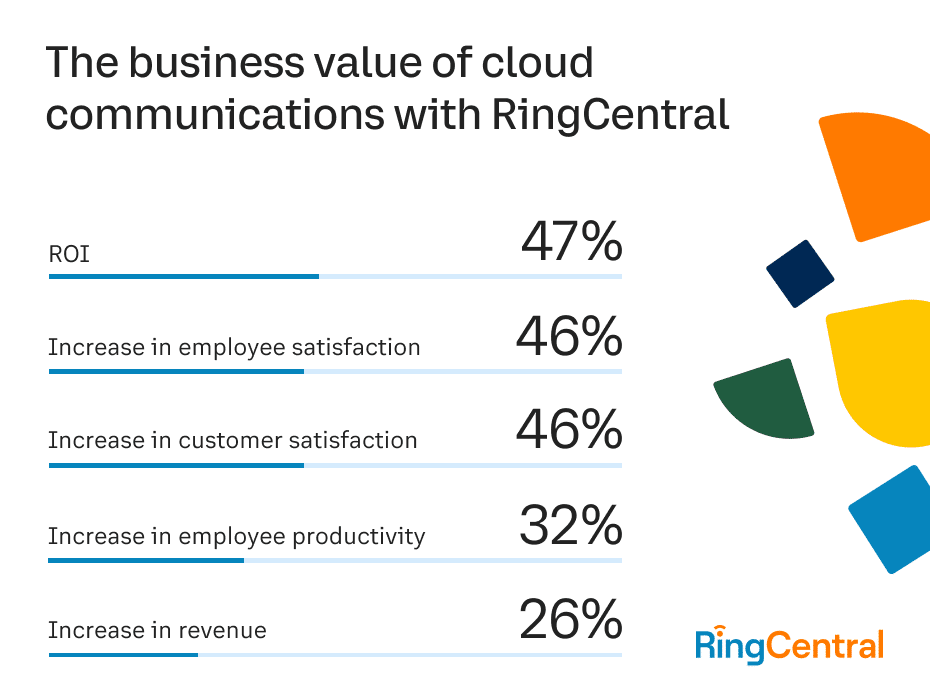When it comes to bringing a nonprofit organization’s mission to reality, every dollar counts. And as RingCentral’s recent Customer Success Metrics Survey has found, cloud communications plays a critical role in optimizing fundraising to achieve greater impact.

Real-life gains and improvements
Encompassing the opinions of more than 500 executives and decision makers in the U.S., Canada, and the U.K., the Customer Success Metrics survey measured the real-life gains and improvements customers have seen since deploying RingCentral—and it revealed some key opportunities for nonprofit organizations to reap greater impact from every dollar they raise.
Overall, the survey found that RingCentral nonprofit customers saw an average 55% return on investment (ROI) within 18 months of deploying our all-in-one messaging, video, and phone cloud solution, including significant productivity gains and cost reductions. But for nonprofits, some specific findings warrant close attention as they reflect significant operational gains that can help such organizations work more effectively towards their ultimate goals.
23% average reduction in IT spend
Communications technology supports all of nonprofits’ most important relationships, including with employees, volunteers, and donors. But it can be a drag on operational budgets, especially when legacy phone systems and/or multiple solutions are in use.
Our Customer Success Metrics Survey found that organizations saw a 23% reduction in IT spend on average—and up to 40% savings at the higher end—due to the improved ease and efficiency of deploying and managing RingCentral. From our centrally managed administrative portal, which allows IT to fully monitor and manage communications tools from anywhere, to a reduction in hardware costs, switching to RingCentral provides significant cost savings—freeing up more dollars to put towards meaningful action that can drive an organization’s mission.
55% increase in employee productivity
Optimizing employee efficiency and productivity can help to direct more funds towards the cause by limiting the need for excess headcount. Productivity improvements also help to ensure that employees drive the greatest impact from their everyday work.
RingCentral customers report overall productivity gains to the tune of 55% on average. They also report key improvements to how work gets done within their organizations, reducing unnecessary tasks and effort in order to drive greater value from people’s time.
For example, customers report a 58% decrease, on average, in in-person meetings and a 55% increase in meeting effectiveness, highlighting how much more nonprofits can achieve when they have the right tools. Our survey also found an impressive 63% reduction in app toggling, demonstrating yet another way RingCentral helps workers get more done every day.
The nonprofit objective: put every dollar to work
While operational efficiency is important across sectors, it’s especially important for nonprofits who must answer to donors and other stakeholders about the results achieved from the funds they raise.
For nonprofits, success is measured by such metrics as cost per dollar raised and other indicators of fundraising efficiency, fundraising ROI, and administrative and operational costs vs. program spending. The better an organization is able to control its costs, the better it can fund its true mission. And not only are such metrics important as an internal performance gauge—they’re also used by prospective donors as they seek out the opportunities to contribute most impactfully.
Says Le’Ana Powell, a Family Engagement Specialist for Oakland Promise’s Future Center, a RingCentral client: “We’re a nonprofit, so we want to direct as much of our operating budget as we can to helping students and their families.” Powell continued:
Being able to have our personal phones double as our work phones when we’re in the field is a great way to help the organization save money.
While the California nonprofit switched to our cloud communications solution to improve the mobility of its field workers, it has seen improvements across the organization that are helping to make greater strides towards its mission of helping public school students acquire vital resources and skills in order to attend college.

Combined, the results of our Customer Success Metrics Survey, as well as the experiences of organizations such as Oakland Promise, highlight that together, RingCentral and nonprofits can indeed change the world.
Tu-Han Phan, RingCentral Senior Social Impact & Diversity Business Partner, says:
When nonprofit organizations are solving some of the world’s most important problems, it’s critical to empower them with seamless, efficient tools so they can focus on what matters most: their mission.
A closer look at the RingCentral advantage
Throughout this #CustomerSuccess blog series, we take a closer look at the RingCentral advantage as illustrated by the survey results and also explore some of the specific improvements seen across key business segments and within industry vertical markets.
To learn more about how RingCentral can help nonprofits improve efficiencies and drive more meaningful outcomes in the process, and to see the full research results, download our RingCentral 2021 customer success metrics: nonprofits datasheet now.

Originally published Jun 23, 2021, updated Dec 30, 2022





